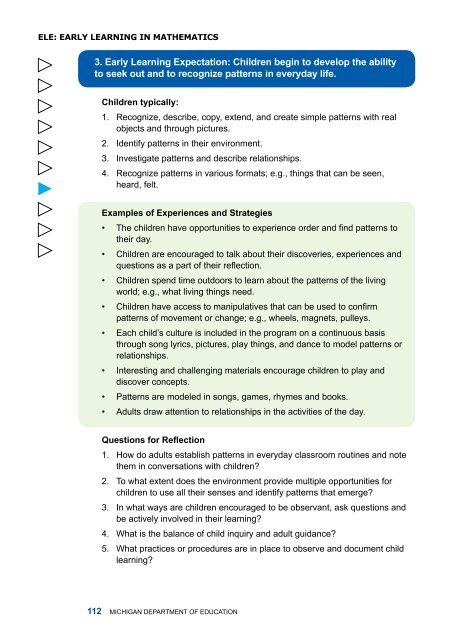Early Childhood Standards of Quality for ... - State of Michigan
Early Childhood Standards of Quality for ... - State of Michigan
Early Childhood Standards of Quality for ... - State of Michigan
You also want an ePaper? Increase the reach of your titles
YUMPU automatically turns print PDFs into web optimized ePapers that Google loves.
ELE: <strong>Early</strong> learning in mathematics3. <strong>Early</strong> Learning Expectation: Children begin to develop the abilityto seek out and to recognize patterns in everyday life.Children typically:1. Recognize, describe, copy, extend, and create simple patterns with realobjects and through pictures.2. Identify patterns in their environment.3. Investigate patterns and describe relationships.4. Recognize patterns in various <strong>for</strong>mats; e.g., things that can be seen,heard, felt.Examples <strong>of</strong> Experiences and Strategies• The children have opportunities to experience order and find patterns totheir day.• Children are encouraged to talk about their discoveries, experiences andquestions as a part <strong>of</strong> their reflection.• Children spend time outdoors to learn about the patterns <strong>of</strong> the livingworld; e.g., what living things need.• Children have access to manipulatives that can be used to confirmpatterns <strong>of</strong> movement or change; e.g., wheels, magnets, pulleys.• Each child’s culture is included in the program on a continuous basisthrough song lyrics, pictures, play things, and dance to model patterns orrelationships.• Interesting and challenging materials encourage children to play anddiscover concepts.• Patterns are modeled in songs, games, rhymes and books.• Adults draw attention to relationships in the activities <strong>of</strong> the day.Questions <strong>for</strong> Reflection1. How do adults establish patterns in everyday classroom routines and notethem in conversations with children?2. To what extent does the environment provide multiple opportunities <strong>for</strong>children to use all their senses and identify patterns that emerge?3. In what ways are children encouraged to be observant, ask questions andbe actively involved in their learning?4. What is the balance <strong>of</strong> child inquiry and adult guidance?5. What practices or procedures are in place to observe and document childlearning?112 <strong>Michigan</strong> Department <strong>of</strong> Education


